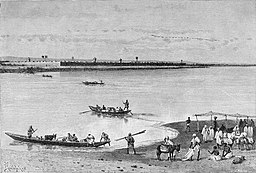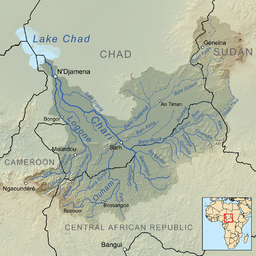Logone River
| Logone River | |
| River | |
|
The Logone-Birni, out of the book The earth and its inhabitants, Africa 1892
|
|
| Countries | Chad, Cameroon |
|---|---|
| City | Kousséri |
| Mouth | |
| - location | Chari River at N'Djaména, Chad |
| - elevation | 364 m (1,194 ft) |
| - coordinates | 12°6′22″N 15°2′7″E / 12.10611°N 15.03528°ECoordinates: 12°6′22″N 15°2′7″E / 12.10611°N 15.03528°E |
| Length | 1,000 km (621 mi) |
| Basin | 78,000 km2 (30,116 sq mi) |
| Discharge | |
| - average | 492 m3/s (17,375 cu ft/s) |
|
Map showing the Logone River within the Chari River drainage basin.
|
|
The Logon or Logone River is a major tributary of the Chari River. The Logone's sources are located in the western Central African Republic, northern Cameroon, and southern Chad. It has two major tributaries. The Pendé River (Eastern Logone) in the prefecture Ouham-Pendé in the Central African Republic and the Mbéré River (Western Logone) at the east of Cameroon. Many swamps and wetlands surround the river.
Settlements on the river include Kousseri, Cameroon's northernmost city, and Chad's capital city, N'Djaména, which is located at the spot where the Logone empties into the Chari river.
The Logone forms part of the international border between Chad and Cameroon.
The flow of the river has been observed over 38 years (1951–84) in Bongor a town in Chad downstream of the union with the Pendé about 450 km above the mouth into the Chari. The Bongor observed average annual flow during this period was 492 m3 / s fed by an area of about 73.700 km2 approximately 94.5% of the total catchment area of the River. Due to the strong evaporation the amount of water flowing into the estuary decreases, in N'Djamena, the flow reduces to 400 m3 / s.
The average monthly flow of the river Logone at hydrological station of Bongor (in m3 / s )
(Calculated using the data for a period of 38 years, 1948–86)
In the eastern lower Logone valley formed out of the Kotoko population several historic sultanates (Kousseri, Logone-Birni, Makari-Goulfey and others) which were vassals of the Bornu or Baguirmi inside the borders of modern-day Cameroon.
...
Wikipedia


